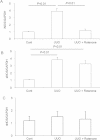Inhibition of Mitochondrial Complex-1 Prevents the Downregulation of NKCC2 and ENaCα in Obstructive Kidney Disease
- PMID: 26207612
- PMCID: PMC4513566
- DOI: 10.1038/srep12480
Inhibition of Mitochondrial Complex-1 Prevents the Downregulation of NKCC2 and ENaCα in Obstructive Kidney Disease
Abstract
Ureteral obstruction with subsequent hydronephrosis is a common clinical complication. Downregulation of renal sodium transporters in obstructed kidneys could contribute to impaired urinary concentrating capability and salt waste following the release of a ureteral obstruction. The current study was undertaken to investigate the role of mitochondrial complex-1 inhibition in modulating sodium transporters in obstructive kidney disease. Following unilateral ureteral obstruction (UUO) for 7 days, a global reduction of sodium transporters, including NHE3, α-Na-K-ATPase, NCC, NKCC2, p-NKCC2, ENaCα, and ENaCγ, was observed, as determined via qRT-PCR and/or Western blotting. Interestingly, inhibition of mitochondrial complex-1 by rotenone markedly reversed the downregulation of NKCC2, p-NKCC2, and ENaCα. In contrast, other sodium transporters were not affected by rotenone. To study the potential mechanisms involved in mediating the effects of rotenone on sodium transporters, we examined a number of known sodium modulators, including PGE2, ET1, Ang II, natriuretic peptides (ANP, BNP, and CNP), and nitric oxide synthases (iNOS, nNOS, and eNOS). Importantly, among these modulators, only BNP and iNOS were significantly reduced by rotenone treatment. Collectively, these findings demonstrated a substantial role of mitochondrial dysfunction in mediating the downregulation of NKCC2 and ENaCα in obstructive kidney disease, possibly via iNOS-derived nitric oxide and BNP.
Figures








Similar articles
-
MnTBAP therapy attenuates the downregulation of sodium transporters in obstructive kidney disease.Oncotarget. 2017 Dec 7;9(1):394-403. doi: 10.18632/oncotarget.23037. eCollection 2018 Jan 2. Oncotarget. 2017. PMID: 29416622 Free PMC article.
-
Inhibition of mitochondrial complex-1 restores the downregulation of aquaporins in obstructive nephropathy.Am J Physiol Renal Physiol. 2016 Oct 1;311(4):F777-F786. doi: 10.1152/ajprenal.00215.2015. Epub 2016 Jul 13. Am J Physiol Renal Physiol. 2016. PMID: 27413198
-
Role of mitochondrial oxidative stress in modulating the expressions of aquaporins in obstructive kidney disease.Am J Physiol Renal Physiol. 2018 Apr 1;314(4):F658-F666. doi: 10.1152/ajprenal.00234.2017. Epub 2017 Dec 20. Am J Physiol Renal Physiol. 2018. PMID: 29357430
-
Salt supplementation ameliorates developmental kidney defects in COX-2-/- mice.Am J Physiol Renal Physiol. 2017 Jun 1;312(6):F1044-F1055. doi: 10.1152/ajprenal.00565.2016. Epub 2017 Mar 8. Am J Physiol Renal Physiol. 2017. PMID: 28274925
-
Rare mutations in renal sodium and potassium transporter genes exhibit impaired transport function.Curr Opin Nephrol Hypertens. 2014 Jan;23(1):1-8. doi: 10.1097/01.mnh.0000437204.84826.99. Curr Opin Nephrol Hypertens. 2014. PMID: 24253496 Free PMC article. Review.
Cited by
-
Expression Profiles of Kidney Mitochondrial Proteome during the Progression of the Unilateral Ureteral Obstruction: Focus on Energy Metabolism Adaptions.Metabolites. 2022 Oct 2;12(10):936. doi: 10.3390/metabo12100936. Metabolites. 2022. PMID: 36295838 Free PMC article.
-
Inhibitors of Oxidative Phosphorylation Modulate Astrocyte Inflammatory Responses through AMPK-Dependent Ptgs2 mRNA Stabilization.Cells. 2019 Oct 1;8(10):1185. doi: 10.3390/cells8101185. Cells. 2019. PMID: 31581537 Free PMC article.
-
Inhibition of mitochondrial complex I by rotenone protects against acetaminophen-induced liver injury.Am J Transl Res. 2019 Jan 15;11(1):188-198. eCollection 2019. Am J Transl Res. 2019. PMID: 30787978 Free PMC article.
-
FTO modulates fibrogenic responses in obstructive nephropathy.Sci Rep. 2016 Jan 4;6:18874. doi: 10.1038/srep18874. Sci Rep. 2016. PMID: 26727661 Free PMC article.
-
MnTBAP therapy attenuates the downregulation of sodium transporters in obstructive kidney disease.Oncotarget. 2017 Dec 7;9(1):394-403. doi: 10.18632/oncotarget.23037. eCollection 2018 Jan 2. Oncotarget. 2017. PMID: 29416622 Free PMC article.
References
Publication types
MeSH terms
Substances
LinkOut - more resources
Full Text Sources
Other Literature Sources
Medical
Miscellaneous

